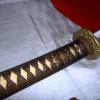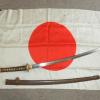Hello, I am new to the entire sword world. Given that I know nothing and I am studying diligently. Please forgive my rudimentary terminology. I would however like an opinion. I just came across a Shin-Gunto at a local auction, deep in the middle of Missouri. It was claimed to be from Okinawa via a US marine. I did as much web research as possible before bidding. I examined the sword and it was very rough but looked authentic based upon my limited research. No rust, but blade looked to have been steel-wooled, and had no bohi (blade groove?). The blade looked/felt like it had never been sharp. The sword and scabbard looked tired, loose and worn out over all but not missing anything except the loop at the end of the tsuka. The tsuba looked to be brass w/washers and the scabbard locking pin still worked but did not engage the scabbard. I was glad to hold one in my hands. It went for $500 US. I did not go that high for fear of condition. My question is this. Is it safe for me to collect "authentic" swords in this condition at these prices while I am still learning. I don't want to pass up everything I see. The sword doesn't have to be perfect just authentic and at a reasonable price. Thank you very much |
|||
 |
Nihonto ClubJapanese Sword Information Exchange |
User login |
|
|
Disclaimer: Nihontō Club owners and independent contributors will not be held responsible for any loss, damage or inconvenience caused as a result of any inaccuracy or error within this website. Except where otherwise noted, this page is licensed under a Creative Commons License.
|




$500
Hey Jeepstar!
Despite my very limited experience placing monetary values on antiques I think it's still very safe to say that $500 could have been way to much but may also have been a real steal. Blades brought back during that time can have been mass produced swords or remounted treasures mishandled by those who brought them back, unaware of the treasure they possessed.
Long story short, I doubt anyone will be able to help with your question without at the very least, a few detailed pictures. At least you still have your 500 bucks. ;)
/Ken
Ken
聞くは一時の恥 聞かぬは一生の恥
(Asking makes one appear foolish. Not asking makes one foolish.)
$500, response
Thanx Ken, I'll try uploading some pics if I can figure it out.
paul
“Crazy Horse had the power to dream himself into the real world,and leave the illusion behind.”
Hi Paul, You may click
Hi Paul,
You may click 'Upload new images' at the top of the page and you'll see what to do.
Regards,
Stan
Photos
Thanx Stan, that was easy. Also I deeply apologize for the file names, they are not mine. I down loaded them from the auction site and just now noticed them after upload.
paul
“Crazy Horse had the power to dream himself into the real world,and leave the illusion behind.”
photoupload
Thanx stan that was nice and easy
paul
“Crazy Horse had the power to dream himself into the real world,and leave the illusion behind.”
advice
That blade "may" be worth 500 as "militaria". I would not really recommend it as a good example of "Nihotou", however. The problem with it in my opinion is that it may not have any "study value". That is, if you can't see the hamon, or the hada, or other important features, what can you look at? If it is signed, you can study the signature, but if it's a typical WWII-period smith, there's not a lot to do there, either.
For the same type of money, you could probably get a blade that is much older, has some features to look at, but does not have mountings (saya, tsuka, tsuba, etc.).
Most of the WWII blades are in a "different class" of collectible. But if you're more interested in militaria (rather than "Japanese art swords"), then things like hamon and hada are not important (because most/many guntou don't really have those features).
Pete
advice
Thanx guys, you've helped me establish a starting benchmark and price-point. I like the idea of thinking on the blade aspect. These swords look really cool stripped down and blown apart. Do folks display them in that manner?
paul
“Crazy Horse had the power to dream himself into the real world,and leave the illusion behind.”
tsunagi
Museums typically display blades "naked". The mountings are displayed separately, with a "tsunagi", which is a carved wood 'blade' that the pieces are assembled onto.
Pete